Spring Has Sprung!
Posted on Thursday, March 20, 2025 · Leave a Comment
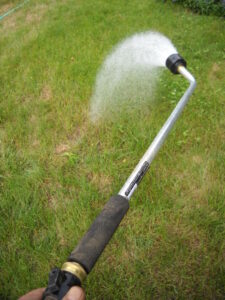
Watering wands get lots of water where you want it.
It’s April, and spring has sprung. Or will soon. Winter always is a sneaky devil, coming back with hard frosts and even a foot of snow on occasion. There is much to do, but start slowly – not just for your back, which has been resting all winter, but because a week of warm sunny days doesn’t mean your soil is warm enough to plant. A soil thermometer pushed 3 inches into the soil should read 50 degrees before planting anything – even spinach and so called cold weather crops.
As you move around your garden you will probably notice that the soil is moist. If you are leaving footprints in the lawn or garden soil, stay off it until it dries out more. Otherwise you can ruin soil structure by compacting it.
You can put down 6-inch planks as walkways in flower beds if you are determined to weed or to remove leaves and debris while the soil is still a bit wet. But even then, be careful. There may be little green noses of perennials or bulbs lurking under the leaves and you won’t want to damage them by putting a plank on them.
I’ve had snowdrops up and blooming since March, as I do every year. By April I have lots of bulbs blooming: crocus, glory-of-the-snow, scilla or squill (a deep purple early bloomer), winter aconite (a bright yellow, short-stemmed beauty) and early daffodils. If you don’t have enough bulbs blooming, imagine where they might go, and put plant labels there for fall planting. A south-facing hillside bed will produce blossoms up to 3 weeks before a north-facing bed.
I plant 100 tulips as cut flowers every year. If you planted some last fall, and have deer in the neighborhood, you may be disappointed to see them eaten just as they are starting to bloom. I prevent this by surrounding and covering my tulip bed with chicken wire before that happens. I plant my tulips in the vegetable garden each fall, and treat them as annuals.
Once your lawn has dried out, it will need a good raking to clean up the winter debris. I like to wait until the lawn has greened up a bit before raking. I don’t want to rake a dormant lawn as it would be easy to damage it with a brisk raking. Think of your lawn as individual plants growing very close together, not as one big green plant. They compete with each other and with crabgrass and weeds. A sprinkling of good compost will improve your soil, giving the lawn a better place to thrive.
I recommend reducing the size of most lawns. Think of a lawn as an area rug, not wall-to-wall carpeting. That will allow you to have a bigger vegetable garden and more places for native trees, shrubs and perennials that will support pollinators and birds. Do you know that caterpillars are essential food for baby birds? We need to provide flowers and trees that the butterflies and moths recognize and use – our natives.

Raised beds are easier to weed and harvest
I recommend raised beds for the vegetable garden, but you don’t have to build or buy wooden boxes for raised beds. When the soil has dried out, loosen it with a garden fork, and then use a short-tined rake to drag soil from walkways onto your designated beds to raise them up six inches or so. A 30-inch wide bed is ideal, it’s wide enough for roots to spread far and wide, yet you will be able to reach all parts for weeding.
Adding compost to your soil every year will improve it greatly over time. An inch of compost works wonders if you do it every year. Buy it in bulk if you have access to a pickup truck, or buy bags if you don’t. And for my tomatoes? I always add a shovel of compost in every planting hole and stir it in well with my favorite weeding tool, the CobraHead weeder. (
www.CobraHead.com). Compost provides not only essential minerals in small quantities, it greatly improves soil texture and its ability to hold water in dry times.
Some people hate weeding, some love it. Either way, it has to be done. Start before the weeds get big. Perennial weeds like dandelions or thistles will already have deep roots. Annual weeds will be tiny, but numerous. I believe the best tool for either is the CobraHead weeder. Its curved metal digging tip can loosen the soil around deep roots, and help you pull from below with the tool while your other hand tugs on the top. Pull gently, slowly. You don’t want to snap off the root, as it will just start growing as soon as you walk away. Annual weeds you can loosen by scuffing the soil lightly.
As you plan your garden, think about buying organically certified starter plants and seeds. Why? Ordinary seed growers feed their plants with liquid fertilizer every day. That means that the plants don’t have to work as hard as organically raised plants to get the minerals they need. Organic practices promote longer roots to get the nutrition needed by the plants. If you are going to grow organic food, you will do best with organic starter plants.
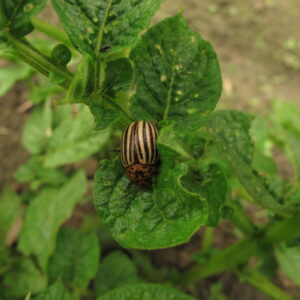
Organic seed producers have to deliver seeds for plants that will not be protected from diseases and pests with chemicals. They have to tough. Lastly, buying organic seeds and plants supports organic farmers. They are working hard to protect the environment by avoiding chemicals. Pay a little bit more if you can, and buy organic.
And remember: gardening is supposed to be fun. Don’t work so hard you get blisters and a sore back. Garden a little every day.
Gardening in March
Posted on Friday, March 14, 2025 · Leave a Comment
Whether March came in like the proverbial lion or lamb for you, March is the time when you need to pay more attention to your houseplants. Instead of watering every Sunday, you probably need to water most things twice a week – except for cacti and a few plants that thrive in dry soil. But rosemary? It’s so easy to kill now. The sun is hotter, roots are growing, and they need more water. Don’t keep the soil soggy, but poke your fingers into the soil more often and make sure it’s not Arizona arid. A dry rosemary is a dead rosemary.
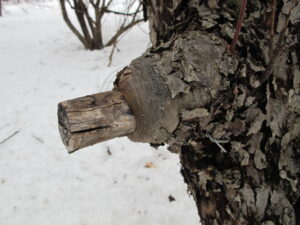
Don’t leave stubs, they have to heal back to branch collar
Although March is the time farmers tend to prune their fruit trees, I am waiting a bit. We still have too much snow to easily move around carrying ladders. Pruning experts will tell you that you can prune fruit trees any month of the year, something I have found to be true. But let’s go over a few rules for pruning.
Use sharp tools. A good pair of hand pruners, some loppers and a pruning saw are all you need. I don’t like bow saws – they can’t get into tight places. Know where to cut. Don’t cut branches flush with the trunk or a big branch. Each branch has a “collar” that should be left. This is the bulge where it heals. But don’t leave long stubs when you remove a branch. They will not heal properly, and look awful. Remove dead branches first.
Never remove more than about a quarter of the leaf-producing branches. Leaves are the engine that drive growth and flower and fruit production. Remove water sprouts each year or two. These start as pencil thin shoots growing straight up, but will get big and clutter up the interior of the tree. Remove branches that are rubbing or crossing others, or are growing in towards the center of the tree. Remember: sunlight should be able to reach every leaf. Open up the interior so this is possible.
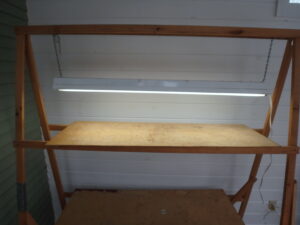
Homemade A frame plant stand for starting seedlings
March is also the time I start planting seeds indoors. Onion family seeds and peppers, hot and sweet, can be started now. Artichokes and cardoon I start early, but tomatoes I don’t start until around April 10. That will give them 8 weeks to be ready to go outside in mid-June.
Actually, it is much easier to order onions as bareroot plants sold in bunches of 50, each a few inches long and ready to start growing in the ground in May. Johnny’s Select Seeds and others sell them, and your local nursery may sell onions in 6-packs, each cell with 4 to 6 seedlings. The main advantage to starting onions or tomatoes by seed is that you get a much wider choice in what you grow.
If you want to start plants indoors, you will need some lights. Yes, some people try a sunny window, but they generally get lanky plants leaning toward the sunshine. Kits with LED or fluorescent lights are sold at garden centers and online. I built my own, a simple A-frame wooden structure that has two plywood shelves and supports 4-foot lights. It can accommodate up to 12 flats of seedlings if I put some on the floor.
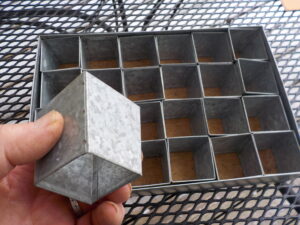
Metal planting cells from Gardeners Supply
Next you need 6-packs of either plastic (like the ones you get when you buy veggies or annuals at the nursery) or re-usable metal or heavy duty plastic ones. In my efforts to reduce my use of single-use plastic, I have switched over to re-usable plant cells. Yes, they are more expensive, but they last forever. In any case, get bigger cells, not smaller ones. Your babies are going to grow in them for 8 weeks or more and need plenty of room for roots.
You can buy seed starting mix, but if you do a lot of plants (as I do), it can get expensive. So you can mix the potting mix with good quality compost if you have it, or you can buy it. Seed starting mixes don’t have much nutrition in them, so adding compost helps. Or later, you can water with a dilute solution of liquid fertilizer, something like Neptune’s Harvest Liquid Fish and Seaweed Fertilizer.
You may wish to buy electric heat mats designed to provide consistent low-level warmth. This signals the seeds that spring is here, and gets them to sprout sooner and with better germination rates. Again, expensive, but they last forever.
Lastly, you can’t let your seeds/seedlings dry out. One way to prevent that is to buy clear plastic covers that fit over a flat of seedlings. Oh, and don’t forget to buy trays to hold your 6-packs. This keeps water from getting on to your table or floor.
Lastly, in March I am reading gardening books and magazines and planning out what I want to do in my flower gardens. I recently got a preview copy of a wonderful book by my friend Jill Nooney called “Bedrock: The Making of a Public Garden”. Jill and her husband Bob Munger have working on their property to develop beautiful spaces to try all sorts of plants. They bought the house in 1980 and have been working on them ever since. They turned over most of the land, gardens and Jill’s sculpture to a non-profit to own and manage last year, but they continue to live in the old farmhouse there and work in the gardens.
Why read this book? It is relevant to anyone who wants to develop great gardens. Jill is a plant collector who has tried just about anything that will grow in a Zone 4/5 garden, and the photos illustrate many of them. The color photos are numerous and beautiful. It is full of design ideas, too. And she has an engaging writing style. I loved the book.
Spring is just around the corner. Get busy now – it will help prevent the mud season blues!
Spring Is On Its Way
Posted on Thursday, March 13, 2025 · Leave a Comment
Here in Cornish Flat, this seems like an old fashioned winter. Temperatures have been consistently below freezing, and the ground has had at least a light covering of snow most of the time. No deep snow, the kind that insulates the ground and keeps tender perennials safe, but enough to sooth the eyes when looking at the landscape.
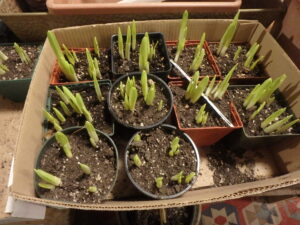
I planted these mini-daffodils last November and they are ready to bloom on a sunny windowsill.
But we gardeners are already thinking of spring. Fortunately, I planted many small pots of Tête-à-tête daffodils last fall, and stored them in my basement which stays at 40 degrees. The foliage is up now, and their roots are pushing though the holes in the bottom of the pots, so I know they are ready to bring up to the warmth of the house. I’ve been putting them in sunny windowsills, and many are blooming – and ready to give away. For me, this is a spring ritual: giving 4-inch pots of flowers to friends and neighbors.
If you are hungering for spring, you might consider going to a spring flower show. Unfortunately, many of spring shows have given up. Boston no longer has its extravaganza, so the Connecticut show in Hartford is now New England’s big event. It has many nice displays and many great classes to attend. This year it is February 20 to 23.
Then there is one of my favorites, the Vermont Flower Show in Essex Junction, Vermont on March 7 to 9. It’s small enough to see everything in one day, but has lots to offer.
In Rhode Island there is the Home Show from April 10 to 13, and it has a flower and garden portion, though I have not been down to Providence since the big flower show folded its tent in 2016.
For the travel-inclined there is the Philadelphia show, March 1 to 9. It was has been a spring tonic since1829. The poinsettia was introduced to American gardeners at that first show, and Ben Franklin may have attended that year. Go on a weekday for smaller crowds, and be prepared to spend a lot – but to have a lot of fun.
February is the month I go through my seed packets to see what I need to buy. Most vegetables and flowers stay viable for 3 years. Exceptions to that rule are all onion-family seeds and parsnips, so I buy them each year. I’ve found that shallots do very well for me and keep longer than onions in the winter, so I will buy new seeds and plant them indoors and keep under lights starting in early March. Peppers of all sorts need a long time to get big enough to plant outdoors, so I also start them in March. Tomatoes I start in April, usually around the 10th.
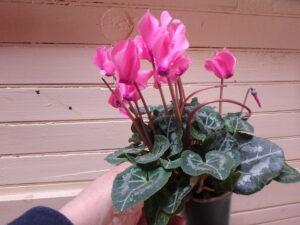
This Cyclamen will bloom for 8 weeks or more in a low light, cool spot
This is also the time of year to pay attention to your houseplants. The days are getting longer, roots and shoots are growing, and they need more water. If you are trying to overwinter a rosemary plant, double the water it gets. A fully dry rosemary is a dead rosemary, and late February or early March is the time of year most of us kill ours. I admit to failing with rosemary by keeping to my weekly watering schedule.
If you have the mid-winter blues, buy yourself some nice cut flowers at your local florist. I prefer buy from a florist, as they generally take better care of their flowers than big box grocery stores. Many years ago I went to the Boston flower market –leaving at 5am – with a friend who owned a florist shop to buy flowers for her shop. The flower market was the size of a football field and had every kind of flower you could imagine. What fun that was!
Some years ago the flower trade got a bad reputation because many of the flowers came from Colombia, South America, where the growers used pesticides liberally and paid their workers a pittance. But I believe that now many flowers in winter are grown in the States and done so with environmentally sound practices. You can always ask your florist where their flowers come from.

Alstormeria is a long lasting inexpensive cut flower
If you want cut flowers that last a long time in a vase, try alstromeria or lisianthus. Both hold up very well. Also excellent are chrysanthemums, asters, sea lavender and bells of Ireland.
Then there are a couple of gorgeous potted flowers that bloom for a longtime at this time of year: cyclamen and Phalaenopsis orchids. The key to these is to minimize watering and to keep them out of direct sunlight. The cyclamen are cheap enough that you can compost them when they are done booming (in 8 to 10 weeks). Phalaenopsis orchids are more expensive but can be saved from year to year.
Lastly, this is a good time of year to think about your outdoor gardens and how you can improve them, come spring or summer. Start by looking out your favorite window. What do you see now that gives you joy? If you only grow flowers, the landscape is bleak.
Think about trees, shrubs and decorative grasses that you could add to the landscape. Would a nice miniature or weeping conifer fit into a perennial bed? A Merrill magnolia in the middle of your lawn could offer a nice shape and buds and bark that please you. It will bloom magnificently with large double white blossoms in April. It will give you something to look forward to. And after all, isn’t that part of the reason why we all garden?
Looking Back On Our Gardens of 2024, And Ahead to 2025
Posted on Thursday, March 13, 2025 · Leave a Comment
I’m not a big fan of unrealistic New Year’s resolutions such as “keep my papers organized and desk tidy”, for example. But I do like to spend some time each January reflecting on the gardens of the past year and making decisions about what I will do in the coming months.
Let’s start in the vegetable garden. In 2024 I planted about 24 kale plants of all colors. In 2025, I shall be more moderate. Yes, kale is healthy for us and freezes well, but I was lax in picking and freezing it in the fall, and wasted some. Shame on me. I use it mainly in stews and soups, or frozen in smoothies.
A new salad green I loved and which, unlike lettuce, never bolted or bloomed, is sold as dandelion. No, it’s not the dandelion we have in the lawn. It’s an Italian “dandelion” which is actually a different species. It is sold fresh in our Coop, I tried it and liked it, so I started some from seed indoors last March, a variety I think is called ‘Clio’ from Johnny‘s Selected Seeds. The leaves get to be 12 to 16 inches long, and they will re-grow if cut, so I harvested it all summer and well into the fall and it never blossomed. I shall plant 6 plants again this year. FYI: it tolerates some shade.
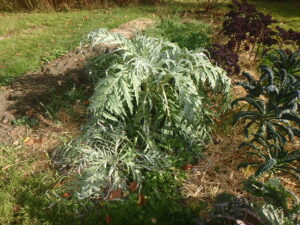
Cardoon has silver leaves and is easy to grow. Start from seed indoors early.
Also on the vegetable front, I grew cardoon this year and will do it again. It is very large leafy plant in the artichoke family. It does not bloom like artichokes, but you eat the midribs of the 3-foot long leaves in fall. I chopped the midribs, boiled till tender, and baked in a cheese sauce. They tasted just like artichokes, but created a lot more food.
This past summer was sunny and, for the most part, dry. We had a great tomato crop, and our flowers performed well too. I did have to water new plantings, as we got little rain.
We are out of sunny spots to add shrubs, so in 2024 we dug out a patch of goutweed – my nemesis – and planted 9 shrubs and a Japanese red maple in an area of part shade, part sun. I was careful to water daily for 2 weeks, and then twice a week for the rest of the summer. The shrubs included 2 native viburnums and 2 mountain laurels, and 3 native hydrangeas, including a great variety for shade called ‘Haas Halo’ (H. arborescens). All did well.
The viburnums are Zone 5 and I have mostly considered our location a Zone 4 (with temperatures most winters colder than minus 20). But in recent years we have not seen lows of even minus 20 degrees, so I am willing to try some Zone 5 plants. Elsewhere I planted a kousa dogwood, a Zone 5 plant that I have tried and lost to winter kill more than once. The Stewartia tree I planted 3 or 4 years ago is also Zone 5, but is doing nicely. I’ll be 79 in April, and by gum, I’m ready to take some chances.
What else worked this past year? Opening our gardens to visitors. We worked hard in the spring to rid ourselves of weeds, sharpen edges of beds, and fill in empty spots. We opened our gardens on select days to various groups and invited friends for a glass of wine and a walk around with us in the early evening. No, our gardens were not perfect – none ever is – but these events were a great time. Try it!
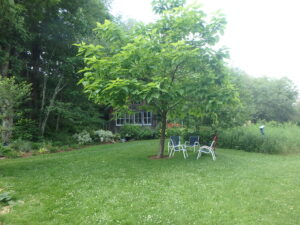
This Catalpa planted 6 years ago provides a nice shady spot to chat or rest.
I’ve had three honey berry plants for 3 or 4 years now, but have not gotten any berries as yet. The bushes (Lonicera caerulea) are in the honeysuckle family and the blue berries are very tasty, I’ve been given some. But so far they have not been able to pick my own. They have not earned their place. I shall tell them this spring to produce berries or they will be gone. I’ve been told that birds love them and will pick them before they are fully sweet and ready for me to eat. The berries turn blue, but are not ripe for a while after that.
The Catalpa tree I planted 6 years ago as an 8-foot tall tree is now 35 feet tall and provides shade for us to sit and relax. It is great tree, blossoming in July. I prune the top each year now to keep it from reaching its 60-foot tall potential. It is a bit weak wooded, so I want to keep it from getting too big. The shade it provides encourages me to sit and relax in the garden, something I want to do more often in 2025.
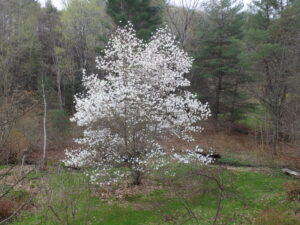
My Merrill magnolia died suddenly without any obvious reason
I am saying a sad farewell to my Merrill magnolia that I planted in 2004. It bloomed reliably each year on my birthday in late April with huge double white blossoms. The shiny green leaves were gorgeous all summer, and the buds in winter look like pussywillows on steroids. It has 5 stems and stands about 60 feet tall and nearly 40 feet across at the crown. But it seems to have died last summer and unless it miraculously recovers in the spring, I shall have it cut down. Sigh.
Okay time for one last resolution: I will keep better records in 2025. I just haven’t found the right way to keep them. I start a yearly notebook, and record some plants. But not all. I’m often too busy working in the garden and plan to do it later. My camera is a good way to record things and I take photos of everything that blooms. But I have literally tens of thousands of photos – and most are largely just organized by date. This year I WILL do better. Happy gardening, and best wishes for 2025.
Holiday Gifts for the Gardener
Posted on Thursday, March 13, 2025 · Leave a Comment
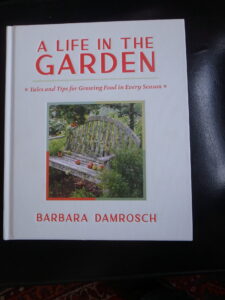
Barbara Damrosch’s new book is a good read.
I am a bit embarrassed to admit this, but I believed in Santa Claus longer than anyone I have ever met. Fifth grade, maybe sixth. To this day, some 70 years later, I still believe in the mystery and joy of giving wonderful gifts that suit the receiver, things that will surprise and delight the recipient – just as Santa always did for me. Let’s look at some great gifts you might consider for your loved ones this holiday season.
Books are always wonderful gifts. My favorite new book is by Barbara Damrosch, author of the fabulous “Garden Primer”. It is called “A Life in the Garden: Tales and Tips for Growing Food in Every Season”. It imparts lots of information from a lifetime of gardening and farming in Maine, alongside her husband, author Eliot Coleman. Along with good information, it has delightful snippets about her life and views. I learned that I can plant rows of carrots just 2 or 3 inches apart – each carrot needs just 4 square inches. I’ve been wasting space! Reading it is like sitting down with a knowledgeable Auntie and listening to stories and tips. Unlike most gardening books, it made laugh outloud, too. Hardback $40.
Another favorite this year is “Plants for the Winter Garden. Perennials, Grasses, Shrubs, and Trees to Add Interest in the Cold and Snow” by Warren Leach. Since we have 5 months or more of cold, this book is very useful. Leach is a prize-winning garden designer, and his book is nicely illustrated with lots of photos and useful information. Hardback $40.
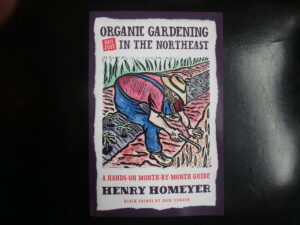
This is a reprint of Henry’s 2011 book.
I would be remiss if I didn’t mention that I have re-printed my book, “Organic Gardening (not just) in the Northeast: A Hands-On Month-by-Month Guide. It is a collection of my articles gleaned from 10 years of this column. Each of the 12 chapters has eight articles relevant to a month in the garden. Get a signed copy by sending $24 To Henry Homeyer, PO Box 364, Cornish Flat, NH 03746.
It’s not just regular visits to the
garden that make a good
gardener: it’s also tools. Good tools make
gardening more efficient, less work and more fun. Every year I mention my favorite weeding tool: the CobraHead weeder (
www.CobraHead.com). It is a curved single-tine weeder that easily gets under weeds and allows you to tease out all the roots. Mine is a steel extension of my hand, and I use it for planting, weeding, and more.
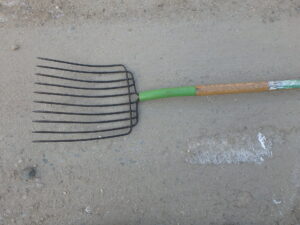
This bedding fork is auseeful tool.
New to me this year is the 10-tine bedding fork. The one I use is made by Ames and comes with a sturdy wooden handle (which is better than fiberglass, I believe). Originally made for cleaning manure out of stalls, it is perfect for moving mulch, wood chips, straw and compost. It can also be used to smooth out the mulch after spreading it.
Watering cans are often a disappointment. I no longer will buy plastic ones – the material often breaks down in the sun after just a few years. But good galvanized metal watering cans can be expensive, and are not often sold at your local garden center or hardware store. Here’s what to look for: get one with a handle that runs from the front to the back of the can. This allows you to easily carry it and to water with one hand. Handles going from side to side require two hands. Size is important. I like big: 2.5 gallons. Smaller people may want smaller cans. Water weighs 8 lbs per gallon. Make sure the rose (nozzle) is removable for cleaning out leaves. Mine is antique, and you might find a good one in a second-hand store.
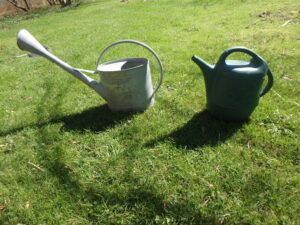
A metal watering can is better than plastic ones
Seeds are good stocking stuffers and offer friends new varieties to try. I started cardoon seeds indoor under lights this year, starting in early February. At maturity, the plants stood up to 3-feet tall with handsome gray-green leaves. Best of all, the ribs of the leaves, when cooked properly, taste just like their relative, artichoke – and provide much more food. Got a favorite winter squash? Give a packet of seeds. Kohlrabi is another lesser-known veggie with seeds you might give to a friend to try.
Heirloom, self-harvested tomato seeds you saved can also be shared if your recipient is willing to start seedlings indoors. Or give seeds from your favorite annual poppies or morning glories.

This bread bag is an alternative to plastic for home made bread.
My wife Cindy and I are committed to minimizing our use of plastic – both for the environment and for our health. Plastic is a petroleum product and has been found to exude micro-particles of plastic that we ingest. If you agree, think about buying glass containers for left overs and store purchases. I get all my deli meats wrapped in paper and transfer them to glass containers when I get home. I recently solved the problem of how to keep bread fresh from the bakery without using a plastic bag for storage: King Arthur Flour makes a cloth bags with an inner bag of waxed fabric. It really works!
Fend Off: Deer and Rabbit Repellent is another good gift. A package contains 25 small cylinders with a close pin attachments. They contain garlic oil and last all winter! These really work for me.
A gift certificate to your local, family-run gardening center is another great choice. It helps them make it through the winter, and it provides choice for your loved one.
 Organic seed producers have to deliver seeds for plants that will not be protected from diseases and pests with chemicals. They have to tough. Lastly, buying organic seeds and plants supports organic farmers. They are working hard to protect the environment by avoiding chemicals. Pay a little bit more if you can, and buy organic.
Organic seed producers have to deliver seeds for plants that will not be protected from diseases and pests with chemicals. They have to tough. Lastly, buying organic seeds and plants supports organic farmers. They are working hard to protect the environment by avoiding chemicals. Pay a little bit more if you can, and buy organic.

















